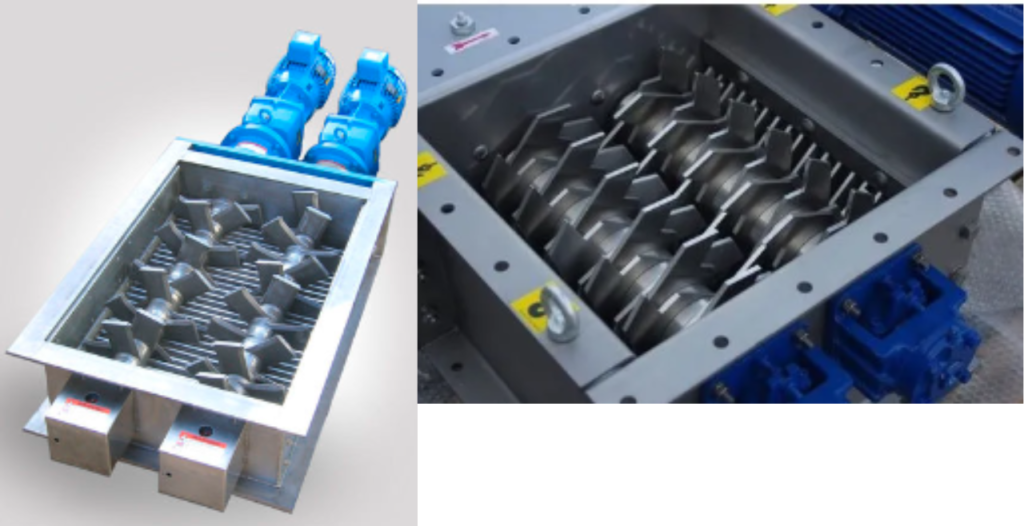GRINDING/MILLING/PARTICLE SIZE REDUCTION TECHNOLOGY & PRODUCTS
De Lumper
| De Lumper, also known as a Lump Breaker or Lump Crusher, is a robust machine used in various industries to reduce the size of aggregated or oversized materials, often referred to as “lumps.” These lumps can form during processing, transportation, or storage, and they need to be broken down into smaller, more manageable pieces before further processing. Below is a detailed overview of De-Lumpers, including their working principles, advantages, disadvantages, applications, materials of construction (MOC), and a summary: |
| Working Principles: |
| The working principle of a De-Lumper involves the following steps: |
| Feeding: The material containing lumps is fed into the De-Lumper through a hopper or other feeding mechanism. |
| Crushing Action: Inside the De-Lumper, a rotor equipped with blades or hammers rotates. The rotor’s motion generates impact and shear forces that break down the lumps into smaller particles. |
| Size Reduction: As the material passes through the De-Lumper, the blades or hammers crush and disintegrate the lumps, reducing their size. |
| Discharge: The reduced material is discharged from the De-Lumper, often onto a conveyor belt or into a container, where it can be further processed or transported. |

| Advantages: |
| Size Reduction: De-Lumpers effectively reduce the size of oversized materials, making them suitable for downstream processes. |
| Enhanced Efficiency: Processing equipment downstream of the De-Lumper can work more efficiently with smaller, more uniform material. |
| Waste Reduction: In waste management applications, De-Lumpers can reduce the volume of waste materials, minimizing disposal costs. |
| Safety: By breaking down large and potentially hazardous lumps, De-Lumpers help improve workplace safety. |
| Disadvantages: |
| Initial Investment: De-Lumpers can be expensive to purchase and install, especially for heavy-duty or specialized models. |
| Maintenance: The heavy-duty nature of De-Lumpers can result in high maintenance requirements, including blade or hammer replacement. |
| Energy Consumption: De-Lumpers can consume a significant amount of energy, especially when processing very tough or hard materials. |
| Noise and Vibration: The operation of De-Lumpers can generate noise and vibration, which may require noise control measures in some settings. |
| Applications: |
| De-Lumpers find applications in various industries, including: |
| Food Industry: For breaking down agglomerates in food ingredients like sugar, spices, and flour. |
| Pharmaceuticals: In the processing of pharmaceutical powders and granules to eliminate lumps. |
| Chemical Industry: For reducing the size of chemicals, pigments, and dyes. |
| Minerals and Mining: In the processing of minerals and ores to break down oversized particles. |
| Waste Management: For reducing the size of bulky waste materials in landfills or recycling facilities. |
| Materials of Construction (MOC): |
| The choice of materials for De-Lumpers depends on the specific application and the materials being processed. Common materials of construction include: |
| Stainless Steel: Often used for the main structure and crushing components due to its corrosion resistance and suitability for food and pharmaceutical applications. |
| Carbon Steel: Suitable for many industrial applications but may require surface treatment for corrosion resistance. |
| Hardened Alloys: In applications where abrasion resistance is critical, hardened steel alloys may be used for the blades or hammers. |
| Summary: |
| A De-Lumper is a robust machine used to reduce oversized materials or lumps into smaller, more manageable pieces. It operates by crushing and breaking down lumps, making them easier to handle, improving downstream process efficiency, and enhancing workplace safety. While De-Lumpers offer advantages like size reduction and waste reduction, they also come with considerations like initial investment, maintenance, energy consumption, and noise and vibration generation. Materials of construction are selected based on the specific application’s requirements. |


 Sales & Marketing:
Sales & Marketing:  Service Supports:
Service Supports:  Website:
Website: 